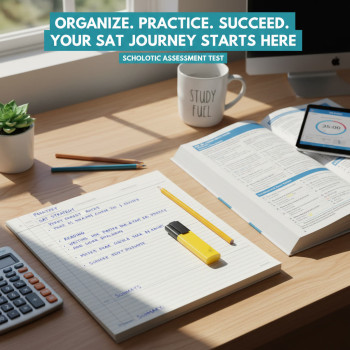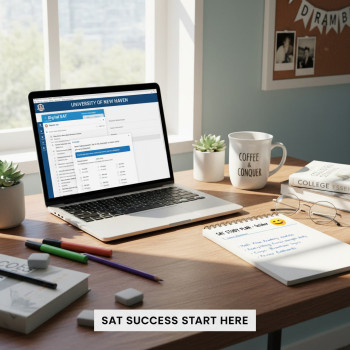Why this conversation matters: switching tests is more than a checkbox
Deciding to switch from the ACT to the Digital SAT (or the other way around) isn’t just an administrative choice — it’s a personal, strategic decision that can affect confidence, time management, and ultimately, college applications. Whether you’re a student who’s realized the test format isn’t playing to your strengths, or a parent who wants to support a calmer, more targeted plan, having thoughtful, well-practiced language makes the conversation easier and more productive.

Quick reality check: what’s different about the Digital SAT and the ACT
Before you start any conversation, have the key facts ready. You don’t need an encyclopedia — just the practical points that explain why a switch could help.
- The Digital SAT is adaptive, shorter, and taken on a familiar device with an integrated graphing calculator in the math portion. Time per question is generally more generous.
- The ACT historically had a separate science reasoning section and a faster pacing. Recent years have brought changes in format and delivery for the ACT; this adds planning complexity for practice and test-day expectations.
- Most U.S. colleges accept either test. Admissions teams generally evaluate scores without inherent preference — the best test is the one where the student performs strongest and feels confident.
Why students switch
- Pacing concerns: some students need more time per question and do better on a test that rewards thoughtful reasoning over quick answering.
- Content strengths: strong algebra and data interpretation skills may favor one test’s format; reading-style differences can favor the Digital SAT or ACT depending on the student.
- Testing environment: preference for digital adaptive testing at home or school can be decisive.
- Test fatigue or timing: a student who has burned out prepping for one test might reset with a fresh start on the other.
How to plan the conversation: tone, timing, and audience
Conversations usually fall into three categories: student-to-parent, parent-to-student (supportive), and student/parent-to-school counselor or coach. Pick your audience, prepare a short explanation, and be ready with a plan so the talk feels solution-focused rather than indecisive.
- Tone: calm, curious, solution-oriented. Avoid defensiveness or panic.
- Timing: choose a neutral, uninterrupted time — not right after a practice test or during a busy weekday morning.
- Length: have a 2–3 minute opener, then details and a plan if the listener wants more.
Scripts: short, medium, and deep versions
Below are ready-to-use scripts organized by audience and depth. Practice them out loud; the first time always feels awkward, but the second feels natural. Swap words so they sound like you.
Student to Parent — Short (quick check-in)
“Hey Mom/Dad, I tried a full ACT practice test and compared it to a Digital SAT practice. On the ACT I felt rushed in the Science/Reading sections, but on the Digital SAT I could think through problems more slowly and my practice score was higher. Can we try focusing on the Digital SAT for a few weeks and see how the next practice test goes? I’ve sketched a short plan.”
Student to Parent — Medium (concise rationale + plan)
“I wanted to talk about switching from the ACT to the Digital SAT. I noticed during practice that the SAT gives more time per question and the reading passages match how I study in class. I also liked the built-in calculator in the math section. My plan is: (1) take one adaptive practice on the Bluebook app, (2) spend four weeks on targeted practice for problem areas, and (3) if scores improve, register for an SAT date in the next available window. It would help to get your support with scheduling and letting my tutor know.”
Student to Parent — Deep (emotion + data + ask)
“I know we’ve been preparing for the ACT, and I appreciate all the help. After a couple of full-length ACTs I felt mentally drained by the timing demands — especially in the science section. I ran a comparison with two adaptive Digital SAT practice tests and saw a 30–40 point increase on average in my practice scores, and I felt less anxious. I think switching will let me show my true skills. Could we switch my focus to the Digital SAT for the next two months? I’ve mapped a study plan, including a few tutoring sessions. Would you help me reach out to my counselor to change the plan?”
Parent to Student — Supportive
“Thanks for telling me how you feel — I want what’s best for your confidence and your applications. Let’s map this out: one practice test on the Digital SAT within a week, a short comparison of time-per-question and content, and then a decision. If it turns out switching helps, we’ll adjust tutoring sessions and dates. I’m proud you’re taking an evidence-based approach.”
Student/Parent to School Counselor
“Hi, could we set up a quick meeting about switching our testing focus? We’ve noticed better practice results with the Digital SAT, and we’d like your guidance on registration deadlines, school testing accommodations if needed, and whether the school will report the right test type to colleges. We’ll bring practice-score snapshots and a proposed timeline.”
Student to Coach or Teacher (asking for help)
“I’m thinking about switching from the ACT to the Digital SAT because the practice tests show stronger results for me on the SAT. Would you be willing to help me identify three academic skills to prioritize in the next five weeks (for example: evidence-based reading strategies, data interpretation, and algebraic manipulation)? Even one quick strategy session would help a lot.”
Scripts for tricky moments: what to say if someone pushes back
Not everyone will immediately understand the switch. Here are short scripts for common pushback points.
“But we already bought ACT materials.”
“I get that — we’ve invested time and money. The good news is many study skills are transferable: vocabulary, reading strategies, and math fundamentals. We’ll reuse what works and focus new time on the differences. If the SAT is a better fit, that reallocation could be an even smarter investment.”
“Colleges prefer one over the other.”
“Most colleges accept either test, and they don’t usually prefer one. The priority is the score that best represents my abilities. I’ve checked a few target schools’ policies, and they accept both. If you want, we can confirm specifics with the counselor.”
“You’re changing your mind too much.”
“I hear you. I don’t want to flip-flop. I’m using practice test results and a small trial window to make a thoughtful decision. If the trial doesn’t show improvement, we’ll stop and reassess. This isn’t an emotional choice — it’s a data-informed test strategy.”
Scripts for communicating with colleges (when necessary)
Most of the time you don’t have to proactively tell colleges you switched tests; you simply submit the score that best represents you. But sometimes you’ll want to explain in an application or counselor note — for example, if testing windows were tight or if you switched because of a documented accommodation. Keep it concise.
Short explanation for a college application
“I initially focused on the ACT but switched to the Digital SAT after practice testing showed improved performance and decreased test anxiety. I believe the SAT better reflects my academic strengths.”
Note for counselor recommendation or school report
“[Student name] completed both ACT and Digital SAT practice tests and elected to submit the Digital SAT due to stronger, more consistent performance on practice and formal administrations. The decision was made in consultation with the student’s parent, counselor, and tutor.”
How to make the switch — a simple action plan (4–6 weeks)
Switching isn’t a single step; it’s a focused process. This plan balances practice, review, and accountability.
- Week 0 — Baseline: Take one full-length ACT and one full-length Digital SAT practice test under realistic conditions to collect baseline scores and feelings.
- Week 1 — Analyze differences: Review which question types and timing points caused issues. List top 3 weaknesses for each test.
- Weeks 2–4 — Targeted practice: Focus on weaknesses for the chosen test. Use adaptive practice (Bluebook) and timed sections. Consider 1–2 sessions with a personalized tutor to accelerate progress.
- Week 5 — Mock test: Take another full-length practice test of the chosen exam, compare scores, and decide whether to proceed with registration for an upcoming test date.
- Ongoing — Maintain practice tests every 2–3 weeks, keep a score log, and refine strategies identified by your tutor or practice analytics.
Table: Practical comparison for decision-making
The table below summarizes the practical distinctions you’ll want to weigh when deciding to switch.
| Factor | Digital SAT (practical) | ACT (practical) |
|---|---|---|
| Test delivery | Digital (Bluebook app), adaptive; many students use their own device. | Mostly paper historically; digital versions expanding—practice availability may vary. |
| Timing per question | More time per question; less speed pressure. | Faster pacing; rewards quick reading and answering under time pressure. |
| Math | Built-in graphing calculator; formula support included. | Bring your own calculator; restrictions apply; no built-in graphing tool. |
| Reading | Shorter passages; discrete questions often tied to a single passage. | Longer passages with multiple questions each; endurance and pacing matter. |
| Practice resources | Official adaptive practice (Bluebook), free Khan Academy personalized plans. | Practice materials available but sometimes spread across platforms; formats can vary. |
| College acceptance | Accepted broadly; most colleges accept either. | Accepted broadly; most colleges accept either. |
Real-world examples: short case studies
These mini-cases illustrate how small changes led to better outcomes for students who switched tests.
Case 1: Maya — from rushed to measured
Maya was a strong reader and algebra student, but ACT practice scores were inconsistent because she felt rushed in multi-question passages and the science section. After trying two adaptive Digital SAT practice tests, her average score rose 40 points and her anxiety decreased. The switch let her focus on evidence-based reading strategies and algebraic reasoning that matched classroom learning.
Case 2: Jordan — pacing made the difference
Jordan excelled at quick pattern recognition and had done well on the ACT’s faster format. But after a schedule conflict and a move to a school offering Bluebook practice, he tried the Digital SAT and, with one month of targeted tutoring, closed the gap and ended up with similar scores on both tests. The key win was discovering which format felt sustainable for late-season retesting.
How personalized tutoring helps — where Sparkl fits in
Switching tests is as much about strategy as it is about content. Personalized tutoring accelerates that process because a skilled tutor can:
- Diagnose which test format suits your strengths with targeted practice tests;
- Create a tailored study plan that reuses strengths from previous prep while addressing new gaps;
- Provide 1-on-1 guidance on timing strategies and real-time practice feedback;
- Use AI-driven insights and progress tracking to refine focus areas quickly.
For students who want support during a switch, Sparkl’s personalized tutoring can be especially helpful: sessions that adapt to a student’s learning style, focused practice centered on the new test’s demands, and clear progress reports that families and counselors can use when making decisions.
Checklist before you finalize the switch
Use this quick checklist to make sure the decision is informed and practical.
- Have you taken a timed full-length practice test for both exams within the last two weeks?
- Do you have a 4–6 week plan for targeted practice post-switch?
- Have you checked registration deadlines and Bluebook/device requirements?
- Have you consulted your school counselor about reporting, accommodations, or in-school testing options?
- Are tutoring resources lined up if you want extra support (for example, 1-on-1 sessions that focus on the new exam)?
Final words: make the choice that reduces stress and improves scores
Switching from the ACT to the Digital SAT or vice versa is a legitimate strategy — not a sign of indecision. The goal is to create the clearest path for a student to demonstrate their abilities under optimal conditions. Use practice data, honest conversations, and a short experimental window to decide. Keep the tone supportive and evidence-based; don’t let identity or sunk cost drive the call.
If you want help putting together practice tests, a comparison snapshot, or a short script tailored to your family’s style, a few focused tutoring sessions can make the transition smoother. Personalized tutoring — like Sparkl’s 1-on-1 guidance with tailored study plans and expert tutors — can translate practice gains into real test-day confidence, helping students present their best selves on the score report that matters most.

Resources you should open next (practical next steps)
Start with these actions right after this conversation:
- Schedule one adaptive practice test on the Digital SAT Bluebook app and one full-length ACT under realistic timing.
- Create a two-column score-and-feeling log: numerical outcomes on one side, test-day emotions and pacing notes on the other.
- Book one or two tutoring sessions focused on the format you’re leaning toward — use them to confirm whether the switch is helping.
- Talk with your counselor about registration dates and any accommodations that might carry over with a test change.
Parting script: what to say to close the loop
Use this simple closing line after any discussion to ensure alignment and next steps: “Thanks for listening — here’s the plan: I’ll take both practice tests this week, summarize the scores and how I felt, and we’ll decide together within two weeks whether to switch. Can we check back on [insert a concrete date two weeks from now]?”
That single line turns a conversation into a commitment that’s measurable, time-bound, and collaborative — exactly the kind of approach that reduces anxiety and improves outcomes.
Good luck. Switching tests can feel risky, but with clear scripts, a short data-driven trial, and the right support (including targeted 1-on-1 tutoring when helpful), it’s a smart, controlled step toward the strongest college application you can submit.













No Comments
Leave a comment Cancel